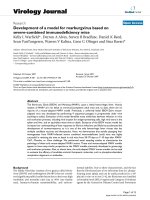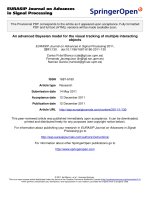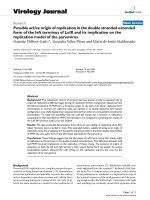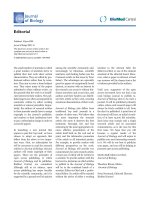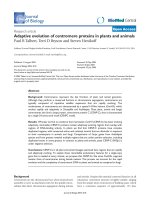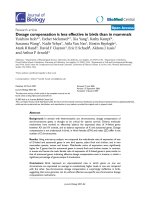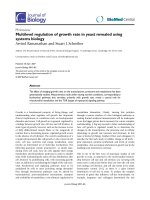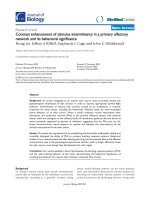Báo cáo sinh học: "Computing approximate monogenic model likelihoods in large pedigrees with loops" docx
Bạn đang xem bản rút gọn của tài liệu. Xem và tải ngay bản đầy đủ của tài liệu tại đây (755.97 KB, 13 trang )
Original
article
Computing
approximate
monogenic
model
likelihoods
in
large
pedigrees
with
loops
LLG
Janss
JAM
Van
Arendonk,
JHJ Van
der
Werf
Wageningen
Agricultural
University,
Department
of
Animal
Breeding,
PO
Box
338,
6700
AH
Wageningen,
The
Netherlands
(Received
30
January
1995;
accepted
11
September
1995)
Summary -
In
this
study
’iterative
peeling’
is
introduced,
a
method
equivalent
to
the
traditional
recursive
peeling
method
for
computing
exact
likelihoods
in
nonlooped
pedigrees,
but
which
can
also
be
used
to
obtain
approximate
likelihoods
in
looped
pedigrees.
Iterative
peeling
is
an
interesting
tool
for
animal
breeding,
where
exact
recursive
peeling
is
generally
unfeasible
due
to
the
abundant
number
of
loops
in
animal
pedigrees.
In
simulations,
hypothesis
testing
and
parameter
estimation
were
compared
based
on
approximate
likelihoods
in
looped
pedigrees
and
exact
likelihoods
in
nonlooped
pedigrees,
showing
no
biases
introduced
by
the
approximation
in
looped
pedigrees.
likelihood
/
pedigree
peeling
/
major
gene
/
looped
pedigree
Résumé -
Calcul
approximatif
de
vraisemblance
pour
un
modèle
monogénique
dans
de
grands
pedigrees
à
boucles.
Dans
cette
étude
on
introduit
une
procédure
itérative
de
condensation
de
l’information
contenue
dans
un
pedigree,
appelée
« épluchage »,
qui
est
équivalente
à
l’épluchage
récursif pour
le
calcul
des
vraisemblances
exactes
dans
des
pedigrees
sans
boucles,
mais
qui
est
également
utilisable
pour
le
calcul
de
vraisemblances
ap-
proximatives
dans
les
pedigrees
à
boucles.
L’épluchage
itératif
est
une
méthode
intéressante
en
génétique
animale
où
la
méthode
récursive
exacte
est
généralement
inapplicable
à
cause
du
grand
nombre
de
boucles
dans
les
pedigrees
animaux.
À
l’aide
de
simulations,
on
a
comparé
des
tests
d’hypothèse
et
l’estimation
de
paramètres
basés
sur
des
vraisemblances
approximatives
dans
des
pedigrees
à
boucles
et
des
vraisemblances
exactes
dans
des
pedi-
grees
sans
boucles,
montrant
qu’il
n’y
a
pas
de
biais
introduit
par
le
calcul
approximatif
dans
des
pedigrees
à
boucles.
vraisemblance
/
condensation
d’information
de
pedigree
/
gène
majeur
/
pedigree
à
boucles
INTRODUCTION
Research
into
the
use
of
major
gene
models
in
animal
breeding
has
been
aimed
mainly
at
approximations
to
a
mixed
inheritance
model,
including
polygenes,
in
one
generation
half-sib
structures
(Hoeschele,
1988;
Le
Roy
et
al,
1989;
Knott
et
al,
1992).
Because
of
the
pedigree
loops
that
arise
in
animal
breeding
situations,
ex-
tension
to
multigeneration
pedigrees
is
difficult.
A
pedigree
loop
arises
when
2
individuals
are
connected
by
more
than
one
path
of
descent
or
marriage
relation-
ships.
Lange
and
Elston
(1975)
described
various
types
of
loops,
among
which
are
inbreeding
loops,
marriage
rings
and
marriage
loops.
In
animal
breeding
pedigrees
these
kinds
of
loops
are
very
common.
In
particular,
multiple
matings
which
are
generally
applied
to
males
and
often
to
females,
result
in
many
marriage
loops
and
marriage
rings.
For
genotype
probability
and
likelihood
computation,
loops
can
only
be
dealt
with
in
an
exact
manner
in
pedigrees
with
a
few
simple
non-overlapping
loops
using
the
traditional
recursive
peeling
method
(Elston
and
Stewart,
1971;
Cannings
et
al,
1976;
Cannings
et
al,
1978).
However,
in
highly
looped
pedigrees,
common
in
animal
breeding,
exact
recursive
peeling
is
too
demanding
computationally
and
recursive
peeling
is
not
flexible
enough
to
allow
for
approximate
computations.
In
this
study
we
introduce
’iterative
peeling’.
Iterative
peeling
is
developed
as
an
exact
method
for
application
in
nonlooped
pedigrees,
equivalent
to
recursive
peeling,
but
which,
unlike
the
original
recursive
variant,
can
be
used
without
modifications
in
looped
pedigrees
to
obtain
approximate
likelihoods.
The
main
objective
of
this
paper
is
to
introduce
iterative
peeling
for
such
approximations
in
looped
pedigrees,
allowing
for
a
more
general
application
of
major
gene
models
in
animal
breeding.
Using
simulations,
the
usefulness
of
the
approximation
for
likelihood-based
hypothesis
testing
and
parameter
estimation
in
looped
pedigrees
is
investigated.
A
monogenic
model
will
be
considered,
which
can
be
extended
to
a
mixed
inheritance
model,
as
will
be
discussed.
RECURSIVE
AND
ITERATIVE
PEELING
In
the
first
section,
recursive
peeling
is
described
for
obtaining
monogenic
model
likelihoods
in
nonlooped
pedigrees.
In
the
second
section,
’iterative
peeling’
is
introduced
as
an
equivalent
method
for
exact
computations
in
nonlooped
pedigrees.
The
equivalent
exact
method
in
nonlooped
pedigrees
can
be
used
as
an
approximate
method
in
looped
pedigrees.
Recursive
peeling
Probability
and
likelihood
computations
in
nonlooped
pedigrees
can
be
done
by
recursive
peeling
(Elston
and
Stewart,
1971;
Cannings
et
al,
1976;
Cannings
et
al,
1978)
using
2
basic
peeling
operations
of
’peeling
up’
and
’peeling
down’.
Roughly,
considering
a
single
family,
a
peel-up
operation
represents
the
information
in
a
family
in
probabilities
for
the
genotype
Gi
of
a
parent
i,
and
a
peel-down
operation
represents
this
information
in
probabilities
for
the
genotype
Gk
for
an
offspring
k.
Here,
a
notation
based
on
Van
Arendonk
et
al
(1989)
is
used,
where
the
result
of
the
peel-up
operation
is
denoted
by
prog(G
i)
and
the
result
of
the
peel-down
operation
is
denoted
by
prior(G
k
).
The
corresponding
notation
in
Cannings
et
al
(1976, 1978)
is
the
R*
( ;G
i)
function
for
peeling
up
and
the
R+( ;G!)
function
for
peeling
down.
Peeling
operations
are
used
recursively,
eg,
the
computation
of
a
prog
term
for
a
parent
based
on
progeny
data
may
include
previously
computed
prog
terms
of
those
progeny,
representing
information
from
grand-progeny.
The
aim
of
peeling
is
to
condense
all
information
from
a
pedigree
into
a
prior
and
prog
term
for
a
single
individual
1,
obtaining
the
likelihood
L
for
all
data
in
the
pedigree
as:
where
f (y, I G
i)
is
the
penetrance
function,
which
is
the
probability
for
the
observed
data
yl
on
individual l,
given
that
it
has
genotype
Gi.
The
individual
may
be
an
individual
from
the
base
population,
in
which
case
the
base-population
genotype
frequency
P(G!)
is
used
in
place
of
prior(G
i
).
Individual
l may
also
have
no
own
data
or
no
progeny,
in
which
case
the
corresponding
penetrance
term
or
prog
term
is
removed.
Computationally
this
is
implemented
using
a
penetrance
or
prog
term
containing
l’s.
Peeling
equations
A
peeling
equation
for
an
individual
is
obtained
by
considering
the
collection
of
possible
base-population
genotype
frequencies,
genotype
transmission
probabilities,
penetrance
probabilities
and
other
peeling
terms
pertaining
to
the
individuals
in
its
family
and
summing
over
all
possible
genotypes
of
the
family
members.
The
terms
thus
entering
a
peeling
equation
are
difficult
to
give
in
general.
Here,
equations
will
be
given
to
use
peeling
in
a
pedigree
structure
with
dams
nested
within
sires.
In
this
structure
a
family
is
a
half-sib
family
of
one
sire
with
several
mates,
containing
groups
of
full
sibs
which
are,
across
groups,
paternal
half-subs.
Three
different
peeling
equations
are
considered:
2
for
peeling
up,
dependent
on
whether
this
is
done
for
a
sire
or
a
dam,
and
1
for
peeling
down.
In
the
peeling
equations,
prior,
prog
and
penetrance
functions
on
family
members
are
specified
in
all
places
where
they
can
enter.
When
these
are
not
relevant,
eg,
when
a
progeny
does
not
have
progeny
of
its
own,
these
are
removed
or,
computationally,
terms
containing
l’s
are
used.
Prior
terms
for
individuals
in
the
base
populations
are
substituted
with
base-population
genotype
frequencies.
To
condense
all
information
in
a
prog
term
for
a
sire
i
the
following
expression
is
used:
prog(Gi) =
rl
jrgj
pr2or(Gj)
fly7lC-T7)Hk!Gk
Pl!’klGi,
Gj)
f(
y
kl
-G
k)
!r!9(CTk)
[2]
where j
=
1
to
ni
are
mates
of
i,
each
mate
having
k
=
1
to
n
ij
progeny,
and
P(Gk !Gi, G! )
is
the
genotype
transmission
probability
of
sire
i and
a
dam j
to
offspring
k.
To
condense
all
the
information
from
a
half-sib
family
into
a
prog
term
for
1
particular
dam
j*
of
the
family,
the
following
expression
is
used:
where
i is
the
sire
of
the
family,
prog-
j.
(G
i)
is
like
in
equation
[2],
but
excluding
dam
j*
and
k
=
1,
n2!*
are
progeny
of
dam
j*.
To
condense
all
the
information
in
a
prior
term
for
1
particular
progeny
k*
with
dam
j*,
the
following
expression
is
used:
where
i is
the
sire
of
the
family,
phs(G
i)
is
a
term
that
includes
information
on
the
paternal
half-sibs
of
k*,
which
is
a
function
of
the
genotype
of
its
sire
i
and
is
computed
as:
Iterative
peeling
Iterative
peeling
is
equivalent
to
recursive
peeling
used
in
nonlooped
pedigrees.
Iterative
peeling
is
based
on
algebraic
partitioning
of
the
likelihood
and
on
repeated
computation
of
peeling
equations,
based
on
the
idea
of
iterative
computation
of
genotype
probabilities
(Van
Arendonk
et
al,
1989).
Partitioning
of
likelihood
The
aim
of
obtaining
the
likelihood
of
all
data
using
equation
[1]
requires
families
to
be
handled
in
a
certain
order
and
requires
peeling,
within
each
family,
to
be
in
a
certain
direction.
Peeling
operations
can
be
used
to
partition
the
likelihood
pertaining
to
parts
of
the
pedigree.
This
partitioning
is
continued
until
parts
are
obtained
pertaining
to
single
families.
This
allows
a
family-wise
evaluation
of
the
likelihood,
and
the
requirement
of
peeling
to
have
a
direction
within
each
family
becomes
obsolete.
Consider
the
pedigree
with
5
individuals
in
figure
1.
In
this
pedigree
2
families
are
present,
one
family
with
individuals
1,
2
and
3,
and
a
second
with
individuals
3,
4
and
5.
Here,
one
partitioning
above
and
below
individual
3
divides
the
pedigree
in
2
families,
with
individual
3
being
in
both
families.
Individual
3
is
called
a
linking
individual.
The
likelihood
for
a
monogenic
model,
assuming
data
is
available
on
all
5
individuals,
is
computed
as:
Now,
L is
multiplied
and
divided
by
Li =!1!2!03
P(Gi)
P(G
2)
P(G
3
) Gi ,
G2)
!(Y1IG
1)
/(y
2!
G2
),
which
is
the
likelihood
of
family
1,
ignoring
data
on
progeny
3.
Some
reordering
yields:
where
the
part
!01!02
P(G
i)
P(G
2)
P(G
3
) Gi ,
G2)
!(Y1IG
d
f(y
2
) G2 )
has
been
iso-
lated.
This
part
is
prior(G
3
).
The
term
defined
as
L1
can
be
rewritten
as
E
G3
I;G1
I;c
2
P(G
1
) P(G
2
) P(G
3I
G1
, G
2
) !(
Y1I
G1
) !(
Y2I
G2
),
which
is
I;c3 prior(G3).
This
simplifies
L
to:
where
prio&dquo;
sC
( G
3)
stands
for
a
scaled,
or
normalised,
prior
term.
Now
the
likelihood
can
be
written
as
L
=
L1L2,
or
ln(L)
=
ln(L
i)
+
ln(L
2
),
with
one
likelihood
term
per
family.
This
is
a
partitioning
using
a
prior
term
for
the
linking
individual.
It
shows
that
for
this
type
partitioning
(i)
in
the
family
where
the
linking
individual
is
a
progeny,
after
the
partitioning,
information
on
the
linking
individual,
ie
own
data
and
progeny
data,
is
ignored;
and
(ii)
in
the
family
where
the
linking
individual
is
a
parent,
a
scaled
prior
term
is
used
for
the
linking
individual.
This
term
is
used
in
a
manner
like
a
base-population
genotype
frequency
for
base
individuals.
The
scaled
prior
term
for
a
linking
individual
1,
is
computed
in
general
as:
Although
the
partioning
is
shown
only
for
1
example,
the
partitioning
is
very
general.
The
term
L1
above
is
in
general
the
sum
of
the
prior
term
for
a
linking
individual
1,
which
is
the
collection
of
all
probability
terms
pertaining
to
anterior
individuals
of
and
the
transmission
probability
to
l,
summed
over
all
possible
genotypes
of
l and
of
its
anterior
individuals.
At
the
same
time
this
term
represents
the
likelihood
of
the
entire
anterior
part
of
the
pedigree
and
l,
excluding
data
on
l.
The
remaining
part
after
the
partitioning,
L2
in
the
example,
is
the
likelihood
of
the
posterior
part
of
the
pedigree
of
l,
including
l with
a
scaled
prior
term.
In
larger
pedigrees
this
partitioning
is
repeated
to
yield
parts
corresponding
to
single
families.
When
repeating
the
partitionings,
results
of
earlier
partitionings
must
be
taken
into
account,
eg,
the
result
that
after
a
partitioning
information
on
a
linking
individual
is
ignored
in
the
family
where
the
linking
individual
was
a
progeny.
The
likelihood
of
a
pedigree
can
be
partitioned
entirely
using
prior
terms.
However,
the
iterative
computation,
as
will
be
introduced
hereafter,
can
be
speeded
up
by
also
using
a
partitioning
of
the
likelihood
using
a
prog
term.
Showing
this
based
on
the
example,
the
likelihood
L
is
multiplied
and
divided
by
a
term
representing
the
likelihood
of
family
2,
ignoring
data
on
individual
3,
L2
=
E
G3
E
G4
E
G5
P
(Ga)
P(G
5I
G3,
Ga)
!(
Y3I
G3)
/(!!G4),
which
leads
to:
2
Here
a
term
E
G4
E
G5
P(G
4)
P(G
5l
G3,
G4)
!(
Y4I
G4)
!(
Y5I
G5)
has
been
isolated,
which
is
prog(G
3
).
The
division
by
L2 scales
this
term,
L2
being
E
G3
!rog(G3).
Hence,
L
is
written
as:
where
prot
C
( G
3)
denotes
the
scaled
or
normalised
prog
term.
For
a
partitioning
using
a
prog
term
it is
seen
that
(i)
in
the
family
where
the
linking
individual
is
a
progeny,
a
prog
s’
term
is
added
as
information
for
the
individual;
and
(ii)
in
the
family
where
the
linking
individual
is
a
parent,
all
information
from
observations
and
from
prior
terms
is
ignored.
The
scaled
prog
term
for
a
linking
individual
l is
generally
computed
as:
Partitioning
in
a
nested
design
In
a
nested
design,
partitionings
are
carried
through
until
parts
are
obtained
corresponding
to
sire
families.
In
such
families,
several
female
parents
can
be
present.
The
linking
individuals
are
all
the
sires
and
dams
of
the
families,
except
when
they
are
in
the
base
population.
In
this
design
we
consider
a
partitioning
using
a
prog
term
for
each
male
and
a
prior
term
for
each
female
that
is
a
linking
individual.
When
all
parents
of
a
family
are
in
the
base
population,
the
part
of
the
likelihood
pertaining
to
such
a
family
is
computed
as:
where
i
indicates
the
sire
of
family
s, j
sums
over
the
dams
of
the
family,
k
indicates
male
progeny
that
are
linking
individuals,
1
indicates
female
progeny
that
are
linking
individuals
and
m
indicates
all
other
progeny.
When
the
sire
of
the
family
is
not
in
the
base
population,
the
term
P(G
i)
f (y2!Gi)
on
the
first
line
of
[5]
is
removed
and
for
each
dam
that
is
not
in
the
base
population
the
term
P(G
j)
on
the
second
line
of
[5]
is
replaced
with
priof’c (G j)
’
The
considered
partitionings
using
prog
terms
for
all
male
linking
individuals
lead
to
this
removal
of
information
from
sires
on
the
first
line
of
[5]
when
sires
are
not
in
the
base
population
and
lead
to
the
inclusion
of
the
prog
sc
for
males
on
the
third
line
of
equation
!5!.
The
considered
partitionings
using
prior
terms
for
all
female
linking
individuals,
lead
to
the
inclusion
of
a
priors!
term
on
the
second
line
of
[5]
when
dams
are
not
in
the
base
population
and
the
removal
of
all
information
of
females
on
the
fourth
line
of
equation
!5!.
Based
on
the
results
from
the
previous
paragraph,
the
likelihood
of
the
entire
pedigree
after
the
partitionings
is:
Repeated
computation
of
peeling
equations
Iterative
peeling
uses
repeated
computation
of
peeling
equations.
The
repeated
computation
is
a
method
to
establish
the
order
in
which
equations
should
be
handled.
Therefore,
iterative
peeling
does
not
require
knowledge
of
such
an
order
beforehand,
as
is
required
for
recursive
peeling.
For
each
individual
a
prior
and
a
prog
term
is
computed
and
remains
stored
because
results
of
peeling
terms
can
be
required
as
input
for
the
computation
of
other
peeling
terms.
Iterative
peeling
computes
a
series
of
solutions
priorlo,
rtorlil,
etc,
for
these
terms.
Starting
values
are
taken
for
individual
i as
pr!or!(Gt) =
P(G
i
),
the
genotype
frequencies
in
the
base
population
and
prog
l°I
(G
i)
equals
1
for
all
Gi.
Iterative
computation
starts
by
computing
prior
[l
] (G
i)
for
each
individual
i,
in
order
of
descending
age.
Evaluation
of
these
prior
terms
is
based
on
prior!l!
terms
of
parents,
which
are
available
because
older
individuals
are
updated
before
younger
individuals,
and
on
prog
lol
terms
of
sibs.
Subsequently,
proglo (Gi)
is
computed
for
each
individual
i,
in
order
of
ascending
age.
Evaluation
of
these
prog
terms
is
based
on
prior!l!
terms
of
mates,
on
prog[l]
terms
of
progeny,
which
are
available
because
now
younger
individuals
are
updated
before
older
individuals,
and
for
female
parents,
on
a
prog
iol
or
prog
[l]
term
of
their
male
mate.
Whether
this
last
term
is
already
updated
as
prog
[l]
depends
on
the
order
in
which
prog
terms
are
computed.
After
computation
of
all
prior!l!
and
prog
[l]
terms
is
completed,
a
new
iteration
starts
computing
prior
[2
]
and
prog!2!,
etc.
Starting
values
are
such
that
prior
lol
terms
are
correct
for
all
individuals
in
the
base
populations,
and
prog
lol
terms
are
correct
for
all
individuals
without
progeny.
Terms
that
can
be
correct
after
the
first
cycle
of
computations
are,
for
instance,
prior
l
1]
terms
of
individuals
descending
from
2
base
individuals
and
prog
[l]
terms
of
parents
without
grandprogeny.
Correct
computation
of
a
term
is
shown
when
in
the
next
cycle
recomputed
terms
are
equal
to
old
terms.
Once
it is
found
that
a
term
is
correctly
computed,
recomputation
can
be
omitted
in
following
iterations
of
the
algorithm.
The
order
in
which
terms
are
found
correct
gives
information
on
the
order
in
which
recursive
peeling
could
be
used.
Generally,
in
each
iteration,
reasonably
large
groups
of
terms
appear
correct,
keeping
the
number
of
cycles
required
to
compute
all
terms
correctly
reasonably
small,
typically
about
the
number
of
generations
in
the
data
set.
When
all
terms
are
found
correctly
computed,
likelihood
of
the
data
can
be
obtained
using
[5]
and
!6!.
Application
in
looped
pedigrees
The
series
of
solutions
prior
f°],
prio!ll,
etc,
obtained
with
iterative
peeling
can
be
considered
as
temporary
solutions
for
the
required
terms,
corresponding
to
solutions
based
on
a
not
yet
fully
determined
peeling
order.
’Temporary’
likelihoods
can
also
be
computed
using
[5]
and
[6]
based
on
a
not
yet
fully
determined
order.
In
nonlooped
pedigrees,
a
peeling
order
can
eventually
be
found
and
temporary
solutions
become
exact.
In
looped
pedigrees,
a
peeling
order
for
recursive
peeling
cannot
be
determined.
In
the
iterative
peeling
algorithm
the
impossibility
of
finding
a
peeling
order
in
looped
pedigrees
is
shown
by
continuing
changes
in
peeling
terms.
In
looped
pedigrees,
these
changes
were
found
to
decrease
in
size
quickly
and
temporary
likelihoods
were
found
to
stabilise,
supplying
an
approximation.
Because
in
iterative
peeling
every
following
update
of
terms
includes
information
from
50%
less
related
individuals,
a
geometric
rate
of
convergence
is
plausible.
As
a
stopping
rule
to
use
the
approximation
in
looped
pedigrees,
we
used
the
average
absolute
difference
between
subsequent
normalised
heterozygote
probabilities,
based
on
computed
peeling
terms.
For
convenience,
only
the
heterozygote
probability,
which
changed
the
most,
was
monitored.
SIMULATION
STUDY
Application
of
iterative
peeling
to
obtain
approximate
likelihoods
in
looped
pedi-
grees
was
the
aim
of
this
study.
Simulations
were
therefore
performed
to
investigate
the
usefulness
of
this
approximation.
Because
exact
computations
are
unfeasible
in
large
looped
pedigrees,
approximate
likelihoods
could
not
be
compared
with
exact
ones.
Hence,
an
indirect
way
to
study
the
approximation
was
found
by
studying
the
distribution of
test
statistics
and
of
parameter
estimates
over
a
number
of
replicated
analyses
in
looped
as
well
as
in
nonlooped
pedigrees.
In
nonlooped
pedigrees
exact
likelihoods
could
be
computed,
serving
as
a
reference.
Simulations
and
analysis
are
based
on
a
biallelic
autosomal
locus
and
a
normal
penetrance
function.
Simulated
data
Data
sets
had
a
nested
structure
each
generation,
with
full-sibs
nested
within
paternal
half-sibs.
Three
different
data
structures
were
used
(table
I),
1
structure
without
loops
and
2
structures
with
loops.
The
data
structures
were
designed
to
contain
approximately
the
same
number
of
observations,
the
same
number
of
base
individuals
(structure
1
vs
2)
and
the
same
family
sizes
(1
vs
3).
In
structures
2
and
3,
the
third
generation
was
produced
by
taking
1
son
from
each
sire
and
1
daughter
from
each
dam,
maintaining
the
same
breeding
structure
across
generations.
No
directional
selection
was
practised,
and
breeding
females
for
a
male
were
each
taken
from
a
different
sire-family.
Half-
and
full-sib
matings
were
avoided,
so
that
inbreeding
was
absent
within
the
3
generations
considered.
The
additional
third
generation
in
structures
2
and
3
caused
many
pedigree
loops
in
the
form
of
marriage
loops.
All
individuals
used
for
breeding
the
last
generation,
ie
120
for
structure
2
and
60
individuals
for
structure
3,
were
involved
in
1
or
more
such
loops,
often
overlapping.
Genotype
Gi
of
an
individual
equals
1,
2
or
3
corresponding
to
genotypes
A1A
1’
AlA2
and
A2A2
at
an
autosomal
locus.
Genotypes
for
individuals
in
the
base
population
were
randomly
sampled
using
genotype
frequencies
according
to
Hardy-
Weinberg
proportions,
after
which
genotypes
of
other
individuals
were
randomly
sampled
based
on
realised
parental
genotypes
assuming
Mendelian
transmission
probabilities.
For
each
individual
a
random
normally
distributed
environmental
component
was
sampled
and
added
to
a
pre-determined
effect
of
each
genotype
to
obtain
a
phenotypic
observation.
Random
numbers
were
generated
using
GGUBFS
and
GGNQF
(IMSL,
1984).
Details
on
the
parameters
used
for
these
simulations
are
given
in
the
following
sections.
Model
and
model
fitting
The
statistical
model
can
be
specified
by
the
probability
terms
in
!2!,
[3]
and
[4]
which
are
P(G
i
),
the
genotype
frequency
in
the
base
population
for
individual
i,
P(GiIG
s,
Gd
),
the
transmission
probability
for
individual
i
given
the
genotypes
of
its
sire
s
and
dam
d,
and
the
penetrance
function
/(<
/
t!G,),
the
probability
for
the
data
y2
on
individual
i
given
the
genotype
Gi
of
individual
i.
From
these
3
terms,
transmission
probabilities
are
assumed
known
to
be
Mendelian.
Genotype
frequencies
in
the
base
population
depend
on
the
unknown
frequency
f
of
the
A1
allele,
assuming
Hardy-Weinberg
proportions
of
genotypes.
The
penetrance
function
for
an
individual
i
is
taken
as:
This
penetrance
function
is
a
normal
probability
density
function
with
variance
a-
2
around
the
mean
JiGi
for
genotype
Gi.
No
dominance
is
assumed.
For
analysis,
means
attributed
to
the
genotypes
are
expressed
as
Ji
1
=
p -
1/2t,
!2
= tc
and
A’3
=
Ji
+
1/2t,
where
t is
the
difference
between
homozygotes,
referred
to
as
the
gene
effect.
The
unknown
parameters
in
the
model
are
then
f,
p.,
t,
and
Q2
.
Likelihoods
were
computed
using
iterative
peeling.
For
structure
1,
without
loops,
computations
were
done
exactly
by
repeating
the
computations
until
no
further
changes
occurred,
having
found
the
order
for
recursive
computation.
For
the
looped
pedigrees
of
structures
2
and
3,
iterative
peeling
was
used
to
obtain
approximate
likelihoods.
The
stopping
rule
was
a
change
less
than
10-
8
for
the
average
absolute
heterozygote
probabilities
of
all
individuals.
The
maximum
of
the
likelihood
was
sought
using
the
downhill
simplex
algorithm
(Nelder
and
Mead,
1965),
using
as
convergence
criteria
the
variance
of
likelihood
values
of
points
in
the
simplex
to
be
less
than
10-
12
.
Comparisons
Looped
and
nonlooped
pedigrees
were
compared
in
hypothesis
tests
and
parameter
estimation.
In
hypothesis
testing,
a
null
hypothesis
postulating
the
absence
of
a
major
gene
is
used,
described
by
a
model
with
parameters it
and
a2,
and
an
alternative
hypothesis
postulating
the
presence
of
a
major
gene
is
used,
described
by
a
model
with
parameters
f,
/1,
t and
a2.
Tests
are
based
on
the
likelihood
ratio
(LR)
test
statistic,
which
is
twice
the
natural
logarithm
of
the
ratio
of
maximum
likelihoods
under
each
hypothesis.
Type
I
error
and
power,
the
complement
of
type
II
error,
were
investigated
at
their
nominal
level,
ie
assuming
the
expected
classical
asymptotic
X2
distribution
for
the
LR
test
statistic
under
the
null
hypothesis
(Wilks,
1938).
Using
the
classical
rules,
rejection
thresholds
were
obtained
from
a
X2
2
distribution
with
2
degrees
of
freedom,
ie
the
difference
in
number
of
parameters
between
the
null
and
alternative
hypothesis.
It
should
be
noted
that
for
testing
mixtures,
these
classical
rules
do
not
lead
exactly
to
the
nominal
type
I
errors
(Titterington
et
al,
1985),
but
this
is
not
of
importance
for
the
comparisons
between
looped
and
nonlooped
pedigrees
to
be
made
here.
The
likelihood
Lo
for
the
null
hypothesis
is
computed
as:
where y
i
are
observations
with
i
=
1, , N,
the
total
number
of
observations,
assumed
normally
and
independently
distributed.
Under
the
null
hypothesis,
the
maximum
likelihood
estimate
for
the
mean
is
íi
=
&dquo;
BYi/
N
and
for
the
variance
is
(;
2 =
&dquo;B(
Yi -
íiO)
2
/N.
Type
I
error
of
the
test
for
a
major
gene
was
investigated
by
simulating
1 000
data
sets
of
each
structure
(table
I),
generating
for
each
individual
only
a
randomly
distributed
error
term
with
U2
=
100
as
phenotype.
Likelihoods
for
the
null
hypothesis
and
the
alternative
hypothesis
were
computed
in
each
of
these
replicated
data
sets,
and
the
likelihood
ratio
test
statistic
was
obtained.
The
number
of
significant
tests
in
these
1 000
data
sets
was
counted
using
rejection
thresholds
of
4.605
and
5.991,
corresponding
to
nominal
type
I
errors
of
10
and
5%.
Power
to
detect
a
major
gene
was
investigated
by
simulating
100
data
sets
of
each
structure
(table
I)
for
3
different
gene
effects
t =
5,
t =
7.5
and
t =
10
and
using
allele
frequency
f
=
0.5
and
residual
variance
U2
=
100.
Hence,
relative
gene
effects
t la
were
0.5,
0.75
and
1.
Power
was
based
on
a
nominal
type
I
error
of
5%,
using
a
rejection
threshold
of
5.991.
Parameter
estimates
were
compared
using
the
100
data
sets
of
each
structure
(table
I)
used
to
investigate
power
with
t
=
10.
RESULTS
Type
I
errors
were
significantly
lower
than
their
nominal,
ie
asymptotically
ex-
pected,
level,
but
comparison
of
type
I
errors
between
looped
and
nonlooped
struc-
tures
did
not
show
significant
differences
(table
II).
This
indicates
that
absolute
values
of
approximate
likelihoods
obtained
are
on
average
close
to
expected
and
that
the
distribution of
the
test
statistic
over
a
number
of
replicates
is
not
signif-
icantly
altered
when
loops
are
present.
Similar
conclusions
can
be
drawn
by
com-
paring
power
of
the
test
under
the
alternative
hypothesis
(table
III).
Parameter
estimates
for
gene
effect
under
the
alternative
hypothesis
are
biased
in
general,
but
estimates
for
gene
effects
as
well
as
allele
frequency
do
not
differ
between
looped
and
nonlooped
structures
(table
IV).
This
indicates
that
location
of
the
maximum
is,
on
average
over
replicates,
not
altered
for
approximate
likelihoods.
Simulated
parameters:
t
=
10
and f
=
0.5.
DISCUSSION
AND
CONCLUSIONS
An
alternative
peeling
algorithm,
called
iterative
peeling,
has
been
presented.
The
iterative
peeling
algorithm
includes
an
algorithm
to
find
an
order
for
evaluating
peeling
equations.
When
an
order
cannot
be
found,
as
in
looped
pedigrees,
an
approximate
likelihood
is
supplied.
In
this
case,
use
of
a
partitioned
computation
of
the
likelihood
is
also
crucial.
Traditional
recursive
peeling
does
not
involve
such
approximations,
because
this
method
only
computes
the
exact
likelihood
once
a
peeling
order
is
found
and
computes
the
likelihood
by
representing
all
pedigree
information
in
terms
for
a
single
individual.
Usefulness
of
iterative
peeling
as
an
approximate
method
in
looped
pedigrees
was
investigated
by
simulations.
At
an
aggregate
level,
ie
compared
on
average
over
a
number
of
replicated
data
sets,
no
differences
were
found
between
looped
and
nonlooped
pedigrees.
Exact
computations
were
unfeasible
due
to
the
large
number
of
loops
in
the
typical
animal
breeding
pedigrees
we
considered,
and
properties
of
iterative
peeling
could
not
be
studied
comparing
exact
and
approximated
likelihoods
in
individual
data
sets.
The
iterative
peeling
method
may
be
of
interest
for
application
in
animal
breeding.
In
human
populations,
pedigrees
are
generally
small
and
loops
are
not
abundant
so
that
exact
computations
can
be
considered
using
more
complicated
forms
of
peeling
(see
Cannings
et
al,
1978).
These
more
complicated
forms
of
peeling
consider
genotypes
on
sets
of
individuals
jointly.
Larger
pedigrees
and
more
abundant
looping
in
animal
breeding,
however,
makes
the
sets
of
genotypes
considered
jointly
too
large
for
exact
computations
to
be
feasible.
Therefore,
approximate
methods
are
required
for
application
in
animal
breeding.
Iterative
peeling
seems
very
suited,
being
exact
without
loops,
and
automatically
supplying
approximate
likelihoods
when
loops
are
present.
Note
that,
due
to
the
partitioned
computation
of
likelihood,
iterative
peeling
also
automatically
handles
pedigrees
consisting
of
independent
families,
ie
data
traditionally
handled
with
sire
or
sire-
and-dam
models.
The
equations
and
partitionings
given
here
could
be
extended
to
allow
for
more
general
pedigrees.
In
particular,
allowance
could
be
made
for
females
being
mated
with
several
males.
In
this
case,
partitionings
should
accommodate
for
’linking
individuals’
being
parents
in
several
families,
rather
than
just
one.
The
monogenic
model
used
could
also
be extended
to
a
mixed
inheritance
model,
the
model
usually
required
for
analysis
of
animal
breeding
data.
In
iterative
peeling
only
uni-
and
bivariate
functions
of
genotypes
are
considered
on
single
families.
This
can
be
combined
with
for
instance
a
Hermitian
integration
(Le
Roy
et
al,
1989;
Knott
et
al,
1992)
to
include
a
polygenic
component.
ACKNOWLEDGMENTS
This
research
was
supported
financially
by
the
Dutch
Product
Board
for
Livestock
and
Meat,
the
Dutch
Pig
Herdbook
Society,
Bovar
BV,
VOC
Nieuw-Dalland
BV,
Euribrid
BV
and
Fomeva
BV.
REFERENCES
Cannings
C,
Thompson
EA,
Skolnick
MH
(1976)
The
recursive
derivation
of
likelihoods
on
complex
pedigrees.
Adv
Appl
Prob
8,
622-625
Cannings
C,
Thompson
EA,
Skolnick
MH
(1978)
Probability
functions
on
complex
pedigrees.
Adv
Appl
Prob
10,
26-61
Elston
RC,
Stewart
J
(1971)
A
general
model
for
the
genetic
analysis
of
pedigree
data.
Hum
Hered
21, 523-542
Hoeschele
I
(1988)
Genetic
evaluation
with
data
presenting
evidence
of
mixed
major
gene
and
polygenic
inheritance.
Theor
Appl
Genet
76,
81-92
IMSL
(1984)
Library
Reference
Manual,
Edition
9.2,
International
and
Statistical
Li-
braries,
Houston,
TX
Knott
SA,
Haley
CS,
Thompson
R
(1992)
Methods
of
segregation
analysis
for
animal
breeding
data:
a
comparison
of
power.
Heredity
68,
299-311
1
Lange
K,
Elston
RC
(1975)
Extensions
to
pedigree
analysis
I.
Likelihood
calculations
for
simple
and
complex
pedigrees.
Hum
Hered
25,
95-105
Le
Roy
P,
Elsen
JM,
Knott
SA
(1989)
Comparison
of
four
statistical
methods
for
detection
of
a
major
gene
in
a
progeny
test
design.
Genet
Sel
Evol
21,
341-357
Nelder
JA,
Mead
R
(1965)
A
simplex
method
for
function
minimization.
Comp
J
7,
147-
151
Titterington
DM,
Smith
AFM,
Makov
EU
(1985)
Statistical
Analysis
of
Finite
Mixture
Distributions.
Wiley
and
Sons,
New
York,
NY
Van
Arendonk
JAM,
Smith
C,
Kennedy
BW
(1989)
Method
to
estimate
genotype
probabilities
at
individual
loci
in
farm
livestock.
Theor
Appl
Genet
78,
735-740
Wilks
SS
(1938)
The
large
sample
distribution
of
the
likelihood
ratio
for
testing
composite
hypothesis.
Ann
Math
Stat
9,
60-62
